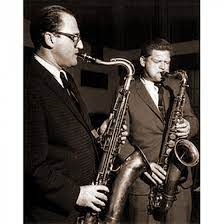Long before I had a driver’s license, I was already going the extra mile, often under the power of my raised thumb, to hear music that mattered to me. Worcester’s Kitty Kat Lounge, where jam sessions on Thursdays and Sundays attracted musicians from all over, became a touchstone in my late teens. But I had to travel to Boston, New York and other far-flung locales to hear the greats of jazz and blues. And as this past weekend indicates, I’m still logging road miles for jazz, this time to East Stroudsburg University in the Delaware Water Gap region of Pennsylvania for Zoot Fest.
Zoot, you must know, is tenor saxophonist John Haley Sims, and true to his spirit, Zoot Fest offered six hours of unadulterated, hard-swinging jazz and good vibes under the auspices of the Al Cohn Memorial Jazz Collection, an archive established at ESU in 1988. Louise Sims was in attendance on Sunday for the formal announcement that her husband’s memorabilia will now become part of the ESU collection. Zoot and Al were musical sparring partners for decades, so it’s entirely fitting that their legacies be combined for posterity. Among the most renowned of Lester Young’s disciples, they first worked together in Woody Herman’s orchestra, the Four Brothers band of the late 40’s, then formed a partnership in the 50’s that became the longest-running of the tenor tandems that figure prominently in jazz lore. What storied combinations: Dexter Gordon and Wardell Gray; Gene Ammons and Sonny Stitt; Eddie “Lockjaw” Davis and Johnny Griffin.
Sunday’s program featured saxophonists Phil Woods and Lew Tabackin, pianists Hod O’Brien and Bob Dorough, bassist Bill Crow, drummers Bill Goodwin and Ronnie Free, and numerous unbilled musicians including sax players Adam Niewood, Jay Rattman, Nelson Hill, and Tom Hamilton, all of whom I was hearing for the first time. Tenor man Niewood locked horns with Tabackin for an exhilarating romp through Thelonious Monk’s “Rhythm-a-ning,” while Lew played a “Body and Soul” that the assembled won’t soon forget. At the end of his riveting performance, Tabackin channeled the final two bars of Coleman Hawkins’ immortal cadenza on Johnny Green’s ballad. It was nice to be in a house that got the allusion. Zoot Fest concluded with two sets by the COTA Festival Orchestra, a swing machine of Water Gap renown that sounded seasoned and crisp on Gerry Mulligan’s arrangement of “Indiana,” and Cohn’s originals “Mama Flossie,” and “The Underdog.”

The afternoon began with an invocation of sorts as Bill Crow sang an acapella version of “Zoot Walked In,” Dave Frishberg’s lyricized treatment of Zoot’s lively original, “The Red Door.” Then Sam Stephenson, author of The Jazz Loft Project, made a presentation about the five-story building at 821 Sixth Avenue in New York City where after-hours sessions took place between 1957 and ’65. During this eight-year period, musicians jammed around the clock for days at a time, none more so than Zoot, who upon ending a night’s work at the Half Note would repair to the loft for further blowing.
On Sunday, Woods recalled that Sims was so compulsive a player that on at least one occasion, when everyone else had split or “passed out,” Phil arrived to find Zoot sitting behind a drum kit keeping time with the foot petals of the hi-hat and bass drum in accompaniment to his tenor. Apropos of this, Bill Crow, who worked extensively with Al and Zoot, has written that as a saxophonist, Zoot’s “great swinging time made him the strongest member of the rhythm section.”
Interest in the long-shuttered jazz loft swelled in 1997 when Stephenson’s research for a biography of the photographer W. Eugene Smith led to the discovery of over 1700 tapes among the materials Smith left to the University of Arizona’s Center for Creative Photography. Both Smith and the painter David X. Young were occupants of 821, and both loved jazz. Amidst the goings-on there, and often in plain sight, Smith recorded hundreds of hours of sounds, including the rehearsals Thelonious Monk held for his 1959 Town Hall Concert. Two CD’s of this material were released commercially in 2001, but the rest awaits clearance by the estates of the participants. Players who made the loft scene included Sunday’s Zoot Fest principals, as well as Art Farmer, Dave McKenna, Freddie Redd, Hall Overton, Steve Lacy, Roland Kirk, Jimmy Giuffre, Art Taylor and hundreds of others, many of whom have passed on.
Zoot Fest stirred both celebratory and elegiac feelings, an increasingly common experience whenever jazz people gather to honor the music’s great players and recall its golden age. Thankfully, there are still a few giants among us, and an impressive number of players worldwide who add a little luster to the glories of the tradition whenever they play the music. I look forward to hearing more of them at next year’s gathering in East Stroudsburg, PA . Kudos to ESU’s Bob Bush, these dedicated musicians, and everyone else involved in the inaugural presentation of Zoot Fest.
